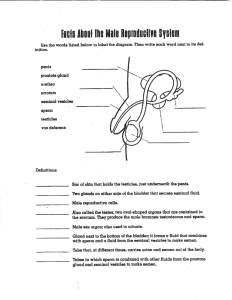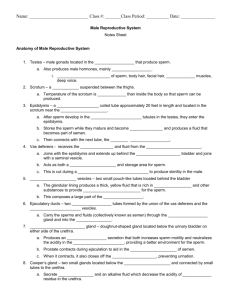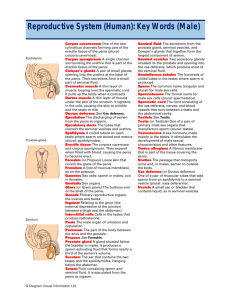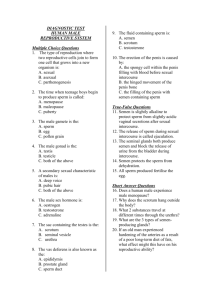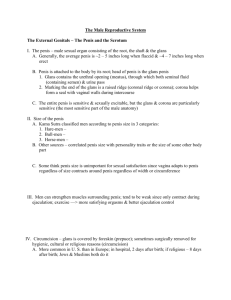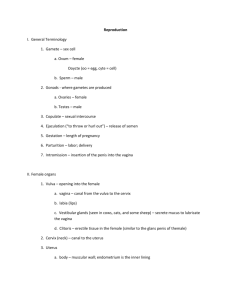Male Sexual Anatomy and Physiology
advertisement
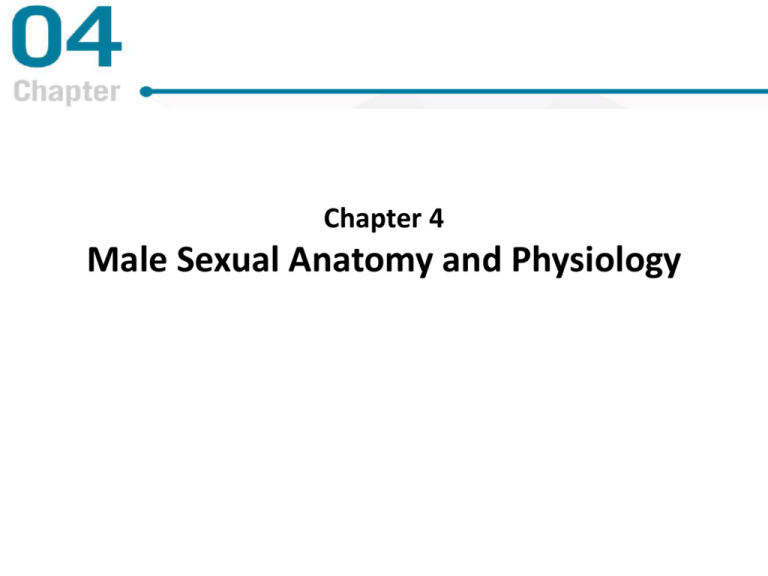
Chapter 4 Male Sexual Anatomy and Physiology The Penis • External anatomy of the penis includes: – Foreskin, glans, shaft, root • Internal anatomy of the penis includes: – Cavernous bodies (corpora cavernosa) – Spongy body (corpus spongiosum) – Penile urethra Why is it important to conduct regular genital self-exams, and what should a man look for? The Penis The Penis • Corona • Frenulum • Glans The Penis The Scrotum • Sac or pouch with two chambers • Muscle layer (tunica dartos) – Pulls sac closer to body in cold temperatures • Spermatic cord The Testes • Testes – Secrete male hormones – Produce sperm • Cryptorchidism – Undescended testis • Self-exam is recommended Underlying Structures of the Scrotum The Testes • Seminiferous tubules – Site of sperm production • Interstitial cells – Major source of androgens • Epididymis – Sperm maturation Internal Structure of a Testis The Vas Deferens • Move sperm from scrotum to ejaculatory duct through prostate • Ejaculatory ducts open into the urethra Male Sexual Anatomy Male Sexual Anatomy • Seminal Vesicle – Secretes 70% of seminal fluid • Prostate Gland – Secretes 30% of seminal fluid • Cowper’s Glands – Secretes fluid before ejaculations – May contain active, healthy sperm • Semen (seminal fluid) – Volume is about 1 teaspoon – 200 to 500 million sperm Erection • Coordinated by autonomic nervous system – Arteries expand – Blood out flow cannot keep up with in flow • Capacity for erection is present at birth • Psychogenic and physiogenic erections Ejaculation • Spinal reflex triggers two phases – Emission • Fluid in urethral bulb – Expulsion • Semen expelled • Retrograde ejaculation • Nocturnal emission Concerns about Sexual Functioning Penis Size • Penis size is seen as a symbol of virility • Erect penises show less variation than flaccid • Size NOT related to sexual satisfaction • Penile augmentation • Genital retraction syndrome Concerns about Sexual Functioning • Phimosis – Extremely tight foreskin • Circumcision – – – – Hygienic value & risk for STI’s question Medical risks Some states are trying to ban circumcision AAP: moderate opposition • Data not significant to recommend routine procedure Male Genital Health Penis Health-Care Issues • Cleanliness – Smegma – Infections • Reaction to vaginal secretions • Injuries • Penile cancer Male Genital Health Testicle Health-Care Issues • Testicular Cancer – More common in young men (20 to 35 years old) – Risk factors – Hard or irregular mass in testes – Survival is greater than 90% if detected early Male Genital Health Prostate Health-Care Issues • Prostate diseases – Prostatitis • enlarged and inflamed – Benign prostatic hyperplasia – Prostate cancer • New guidelines from the USPSTF – Healthy men should not have the PSA test • Treatment options for prostate cancer
